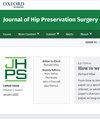The relationship between pre-operative pain characteristics and periacetabular osteotomy outcomes in patients with acetabular dysplasia
IF 1.4
4区 医学
Q3 ORTHOPEDICS
引用次数: 2
Abstract
ABSTRACT The aims of this study were to determine if pre-operative pain characteristics (location of maximum severity of pain, presence of non-groin pain, maximum severity of pain and number of pain locations) affect patient-reported outcome measures in patients undergoing periacetabular osteotomy (PAO) for acetabular dysplasia. We reviewed 52 hips (48 patients) treated with PAO for acetabular dysplasia from February 2017 to July 2020 using modified Harris Hip Score (mHHS), Hip Outcome Score (HOS) and international Hip Outcome Tool (iHOT-12) score, radiographic analysis and pain location/severity questionnaires. Descriptive statistics, analysis of covariance and Spearman partial correlation coefficients were implemented. Twenty-six hips experienced the most severe pre-operative pain in the groin, and 26 hips experienced equal or greater pain in a non-groin location. Outcome scores between these groups were not significantly different (mHHS P = 0.59, HOS P = 0.48, iHOT-12 P = 0.99). Additionally, the presence of pre-operative pain in any non-groin location had no significant relationship with PROM (all P-values ≥0.14). Furthermore, the maximum severity of pre-operative pain and number of pain locations showed no significant relationship with PROM (maximum severity: mHHS P = 0.82, HOS P = 0.99, iHOT-12 P = 0.36; number of pain locations: mHHS P = 0.56, HOS P = 0.10, iHOT-12 P = 0.62). Varying pre-operative pain characteristics do not appear to have any significant impact on outcomes. Therefore, a wide array of patients with acetabular dysplasia might expect similar, favourable outcomes from PAO regardless of pre-operative pain characteristics.髋臼发育不良患者术前疼痛特征与髋臼周围截骨结局的关系
摘要本研究的目的是确定术前疼痛特征(最大疼痛程度的位置、非腹股沟疼痛的存在、最大疼痛程度和疼痛位置的数量)是否会影响因髋臼发育不良接受髋臼周围截骨(PAO)的患者报告的结果。我们使用改良的Harris髋关节评分(mHHS)、髋关节结果评分(HOS)和国际髋关节结果工具(iHOT-12)评分、放射学分析和疼痛部位/严重程度问卷,回顾了2017年2月至2020年7月接受PAO治疗髋臼发育不良的52个髋关节(48名患者)。采用描述性统计、协方差分析和Spearman偏相关系数。26个髋关节在术前腹股沟疼痛最为严重,26个髋在非腹股沟部位疼痛相同或更大。两组之间的结果得分没有显著差异(mHHS P = 0.59,HOS P = 0.48,iHOT-12P = 0.99)。此外,任何非腹股沟部位的术前疼痛与胎膜早破没有显著关系(所有P值 ≥0.14)。此外,术前疼痛的最大严重程度和疼痛部位的数量与胎膜早破没有显著关系(最大严重程度:mHHS P = 0.82,HOS P = 0.99,iHOT-12P = 0.36;疼痛部位数量:mHHS P = 0.56,HOS P = 0.10,iHOT-12P = 0.62)。不同的术前疼痛特征似乎对结果没有任何显著影响。因此,无论术前疼痛特征如何,广泛的髋臼发育不良患者都可能期待PAO的类似、有利的结果。
本文章由计算机程序翻译,如有差异,请以英文原文为准。
求助全文
约1分钟内获得全文
求助全文

 求助内容:
求助内容: 应助结果提醒方式:
应助结果提醒方式:


